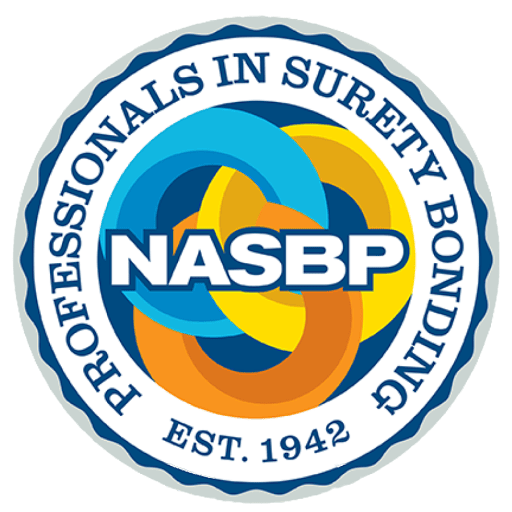December 2006
 |
|||||||||||||||||||||||||||||||||||||||||||
| As we pause to reflect on 2006 and look forward to new opportunities in 2007, it is important to remember what a good year 2006 was for our industry and NASBP. The surety industry appears to have benefited from another profitable year. This is welcome news to everyone concerned about the industry and those dependent on its success for their success. As the surety industry s profitability trickles down to us on the agent and broker side, the fun begins to return to the business.Before we get carried away, we should keep in mind some of the same advice we give to our own clients when they have a great year and practice what we preach.
We should congratulate, celebrate, and then follow our own simple and obvious advice, so we are mindful of what made us successful in the first place. That advice usually sounds something like this:
Let s be thankful for a good economy, a strong construction market and the factors that are out of our control that contributed to the great results in 2006. I hope everyone has a great holiday season and remembers the men and women in the Armed Services who are away from home protecting us all. |
|||||||||||||||||||||||||||||||||||||||||||
|
|
|||||||||||||||||||||||||||||||||||||||||||
 |
|||||||||||||||||||||||||||||||||||||||||||
| It s tempting (and sometimes foolhardy) at this time of year to try to envision the challenges and opportunities that await bond producers and their clients in the coming year. However, I will risk one prediction: if big facility owners, such as the U.S. General Services Administration (GSA), have their way, 2007 may constitute a tipping point where application of virtual three-dimensional and four-dimensional information modeling technology, also called building information modeling (BIM) technology, will find root in a growing number of public and private construction projects. In simplistic terms, BIM can be said to be a model-based technology in which one software database is used by project participants for all design and construction processes.GSA, the largest public real estate organization in the country, recently announced plans to require that all proposals from the A/E/C community for federal public buildings include provision for a building information model. Large private owners, such as Intel and General Electric, also are pushing hard for greater awareness and use of BIM technology by the A/E/C community. In October, the Construction Users Roundtable (CURT), an association of prominent construction owners of which GSA, Intel, and General Electric are members, announced that it is partnering with the American Institute of Architects (AIA) and the Associated General Contractors of America (AGC) on an initiative, called 3XPT Strategy Group, to identify collaborative strategies permitting construction project participants to more fully implement and benefit from technological innovations such as BIM.
Why such owner interest in project collaboration and optimal use of virtual design and construction technology? Simply put, owners want better value out of the design and construction process. Owners also want to stay competitive in the global marketplace, and they realize that the design and construction of facilities is another area of their operations requiring better efficiency and optimization to stay competitive. BIM technology is not new, however. Certain kinds of engineered projects have been employing BIM technologies for years, but the broader design and construction community has been slow to adopt such technologies. AIA and AGC are trying to change that by developing materials to acquaint their respective memberships with the significance of BIM; in fact, AGC recently released a 48-page publication, titled The Contractor s Guide to BIM (which is available from AGC at www.agc.org), to help contractors understand and get ready for the BIM transformation. Some commentators also are relating that, in order to realize the full potential of BIM technology, project relationships may need to be rethought and restructured, so they reflect a more collaborative philosophy and working relationship. What is the interest of surety bond professionals in this industry discussion? Plenty! At some point in the not-too-distant future one or more of your contractor or specialty contractor clients may be required to participate in a major project utilizing BIM or related technologies. How will this impact that client s existing risk management practices? What risks might that client knowingly or unknowingly be assuming in a BIM environment? Will related risks, such as standards of care, ownership of documents, costs of new hardware and software, and responsibilities for project communications, be accounted for sufficiently in the prime contract and in the subcontracts? Are your client s existing insurance policies and surety credit sufficient for a design and construction environment utilizing BIM and related technologies? I do not presume to have even partial answers for these issues, but I am sure that they pose questions to which we should be devoting significant thought. Vigorous industry discourse will be necessary to approach and to find solutions for such questions, and surety bond professionals will have an important role to play. For example, there is, at present, a dearth of industry standards, in the form of standardized protocols and contract forms, to provide guidance. Through its involvement with the Construction Industry Contracts Coalition (CICC), which includes representatives from AGC, CURT and other industry organizations, NASBP has been and continues to be an active participant in one effort to develop such standards, working on drafts of the next generation of standard form agreements and other project documents that account for collaborative relationships and permit use of BIM technology among project participants. Much work remains, however, but rest assured that NASBP will be in the thick of the dialogue. These materials are provided to NASBP members solely for educational and informational purposes. They are not to be considered the rendering of legal advice in specific cases or to create a lawyer-client relationship. Readers are responsible for obtaining legal advice from their own counsels, and should not act upon any information contained in these materials without such advice. |
|||||||||||||||||||||||||||||||||||||||||||
|
|
|||||||||||||||||||||||||||||||||||||||||||
| Applicants for a bond guarantee of a project in a disaster area now can qualify for the SBA Surety Bond Guarantee Program (the Program) by meeting either the SBA s $6.5 million standard for a small business or the prevailing size standard in the applicant s industry, whichever is higher.The SBA established this new rule, published in the Federal Register Vol. 71, No. 205 at 62204 on October 24, 2006, to expand the availability of Program assistance for reconstruction and recovery of the U.S. Gulf Coast Region and of Florida, which the President declared disaster areas following Hurricanes Katrina, Rita and Wilma in 2005.
The new rule, which became effective November 24, 2006, will help the many small construction and service contractors who need this assistance now and in the near future, according to the SBA. The most significant benefits of this rule will flow to small construction and service contractors that had not been eligible for SBG assistance, because their average annual receipts exceeded $6.5 million. Under this new rule, they are eligible, if they (together with their affiliates) meet the small business size standards for their primary industries or the current SBG $6.5 million standard, whichever is higher, as well as meet the other requirements as to place of contract performance. For further information about this new rule, click here to see the notice published in the Federal Register. The SBA believes these new amended size standards will need to remain in effect for at least three more years or until the SBA determines that they cause an adverse effect on local small businesses or that they are no longer needed. If the SBA should decide to terminate the size standard, it will publish a proposed rule and seek public comment. The Pipeline will keep you apprised of any developments with regard to this rule. |
|||||||||||||||||||||||||||||||||||||||||||
|
|
|||||||||||||||||||||||||||||||||||||||||||
| During the 2005/2006 election cycle, the SuretyPAC raised over $20,250 and provided a total of $13,000 in disbursements to both Senate and House candidates. As recommended by the SuretyPAC Committee, the following candidates received a contribution from the SuretyPAC to assist in his/her election or re-election campaign.SURETYPAC CONTRIBUTIONS Note that an asterisk (*) indicates that the candidate was elected or re-elected.
NASBP thanks all SuretyPAC contributors who helped make the SuretyPAC s efforts during the 2005/2006 election cycle a success. To see a listing of the SuretyPAC members by level of contribution (Gold, Silver or Bronze) to the PAC, click here. If you would like to contribute to the SuretyPAC in 2007 and have not already completed an authorization form, please contact Kathy Hoffman at khoffman@nasbp.org.
|
|||||||||||||||||||||||||||||||||||||||||||
|
|
|||||||||||||||||||||||||||||||||||||||||||
| On November 11, at a joint meeting of representatives of the American Subcontractors Association (ASA) and of the Associated Specialty Contractors, Inc. (ASC), an umbrella organization of nine specialty contractor associations, Mark McCallum, NASBP General Counsel and Director of Government Relations, provided a presentation in Tucson, Arizona on Legislative Efforts Undermining Payment Bond Protections for Subcontractors on Public Work. To view a copy of the PowerPoint presentation, click here. NASBP was asked to present on the topic as part of the implementation process of the partnering agreements signed with ASA and ASC. The presentation emphasized the importance of state Little Miller acts in providing payment remedies to subcontractors on public work projects.Among the legislative issues discussed were the potential impacts of legislative initiatives on bonding thresholds, bonding waivers, unregulated sureties, and public/private partnerships. The presentation also addressed the importance of reviewing alternative project delivery legislation to ensure adherence to statutory bonding requirements, and copies of the NASBP position statement on that subject were distributed to ASA and ASC representatives. To view a copy of the position statement, click here.
NASBP, ASA and ASC plan to exchange information and to work with one another to analyze and to address legislative issues of mutual interest in the 2007 state sessions and at the federal level. |
|||||||||||||||||||||||||||||||||||||||||||
|
|
|||||||||||||||||||||||||||||||||||||||||||
| What is a License and Permit Bond?A license or permit is a legal document issued or granted by the appropriate legal authority which allows a business or individual to engage in a certain activity. When the license or permit is issued, many times the code requires a bond be posted. This License and Permit Bond (L&P) guarantees the business or individual will comply with and follow the rules set by the regulatory body that allows them to conduct business within its jurisdiction.
What is the Industry Experience? According to the SFAA, the last twelve years, produced $3.7 Billion in premium yielding a 16.9% loss ratio in L&P Bonds. Obviously, carriers want this level of profitability and premium in their mix of business so it follows that companies try to make writing this business painless. Of course, there are varying levels of underwriting required for each of the L&P classes. Many class codes require only limited underwriting in the form of an application and/or credit check and others require complete financial disclosure. On the former the return is less, but the process is simple. On the latter, the underwriting is focused on the ultimate risk and aggregate exposure that develops when writing multiple bonds for a particular client. Either way, the SFAA loss ratios in all classes of L&P have traditionally been superb and continue to represent very profitable lines of business. What Opportunities Exist for You? As an insurance agent or broker, our work environment is highly regulated by each state and, as such, there are various licensing and bonding rules in all 50 states. This is the first reason to be interested in L&P bonds, if only to be sure that you and other producers in your office are in compliance with statutory requirements. These laws may call for either a resident or a non resident L&P bond. Be sure you know the statute for both the state in which you are domiciled and other states in which you do business. Do not forget that most states require the individual that signs the bond to be licensed there, not just the agency. We are all familiar with contractor license bonds. For a contractor the appropriate legal authority can be a state, state agency, county, township, city, town or village. It all depends upon where the contractor and the job are located. Many other types of business activities are regulated by the granting of a license or permit and require the posting of a surety bond. Being familiar with the bonding requirements for the various types of commercial accounts handled by your office can be a source of additional income for your agency. In addition to this, simply knowing all of the L&P bonding requirements allows you to be a central source for your client s needs and is an important reason why the client would never need to seek another agent. Let s open the door to more opportunities. Consider some of the old line regulated businesses which require bonds and think of the old Surety Association of America rate manual (ceased being printed in 1989). In this manual each main classification of bond had its own colored paper; license and permit bond types were on golden rod colored paper. Some of the major business classifications found on the all state pages is as follows:
All of the above date back to the late 1980 s. Now think of how business activities have changed and new ones have been initiated. The internet and the collateral businesses it has spawned are new and in many cases, regulated at some level. The one historical category which may have experienced the most growth is franchise all. This now includes cable companies, internet connection companies, wireless internet service providers and cell phone towers just to name one niche. These all require bonding. The agent that handled that small start up business in the early 1990 s that needed an L&P bond might have seen the company evolve into a major surety account. Does anyone know what the next major business activity requiring a single license or permit bond will be? Solving someone s small or unusual requirement can lead to much bigger things. Consider the person who may have said no to the founder of Starbuck s when their first bond was needed. If you or your staff has questions about a type of bond and the basic underwriting requirements, please consult the NASBP on-line manual at http://www.nasbp.org/membersonly_files/memlogin.cfm which is free to members of NASBP. Stay on the lookout for additional articles that are dedicated to the Commercial Surety line. This is the second of a series of articles on Commercial Surety. Prepared by NASBP s Commercial Surety Committee Chair, Lynne W. Cook. She is Sr. Vice President of Early, Cassidy & Schilling, Inc. in Rockville, MD. |
|||||||||||||||||||||||||||||||||||||||||||
|
|
|||||||||||||||||||||||||||||||||||||||||||
 SAN ANTONIO, TX – The 2006 Regions 4, 5, 6 & 7 Annual Meeting in San Antonio provided a real life “bridging the generations” opportunity for several generations of San Antonio’s Thomas Jefferson High School graduates to gather.From left to right: Bob Cave/SureTec (1967 graduate), John Hannum/ICW (1960 graduate), Don Cornell/AON Risk Services of Texas (1974 graduate), Stewart Duke (1949 graduate), Ace Tinch/Harding-Conley-Drawert-Tinch Insurance Agency, Inc. (1950 graduate) and Judy Cornell who was a Thomas Jefferson High School Cheerleader. SAN ANTONIO, TX – The 2006 Regions 4, 5, 6 & 7 Annual Meeting in San Antonio provided a real life “bridging the generations” opportunity for several generations of San Antonio’s Thomas Jefferson High School graduates to gather.From left to right: Bob Cave/SureTec (1967 graduate), John Hannum/ICW (1960 graduate), Don Cornell/AON Risk Services of Texas (1974 graduate), Stewart Duke (1949 graduate), Ace Tinch/Harding-Conley-Drawert-Tinch Insurance Agency, Inc. (1950 graduate) and Judy Cornell who was a Thomas Jefferson High School Cheerleader. |
|||||||||||||||||||||||||||||||||||||||||||
|
|
|||||||||||||||||||||||||||||||||||||||||||
| The Department of the Treasury’s Listing of Approved Sureties (Department Circular 570) has been updated to reflect:1. Sirius America Insurance Company has changed its name to Delos Insurance Company effective August 2, 2006.
2. As of June 30, 2006, the name change of American Re-Insurance Company to Munich Reinsurance America, Inc. (NAIC# 10227). 3. An additional surety license for American Contractors Indemnity Company (NAIC# 10216). The following state has been added: NY.4. The Guarantee Company of America USA (NAIC# 36650) has changed its address to 25800 Northwestern Highway, Suite 720, Southfield, MI 48075-8410. 5. Beazley Insurance Company (NAIC #37540), has been certified and added to the Treasury’s Listing of Approved Sureties effective 11/09/06. 6. Philadelphia Indemnity Insurance Company (NAIC #18058), has been certified and added to the Treasury’s Listing of Approved Sureties effective 11/09/06. For a complete listing of all states where these companies are licensed to transact surety business, please refer to the Circular 570 at: http://fms.treas.gov/c570/c570.html |
|||||||||||||||||||||||||||||||||||||||||||
|
|
|||||||||||||||||||||||||||||||||||||||||||
With deepest condolences to NASBP President Stephen Cory, we report that his mother, Mathilda “Tula” Vitrana Cory, age 86, passed away December 1, 2006. She was a life long resident of New Orleans, Louisiana. Tula retired as the Director of Medical Records at Southern Baptist Hospital. She was a founding member of the Louisiana Health Information Management Association (LHIMA) where she served as both President and Vice-President as well as an officer in the Greater New Orleans Medical Records Association. She was preceded in death by her husband: Leon Cory; parents: Anthony Vitrano and Rosa Palmerio Vitrano; and her sister: Helena V. Cash. Survivors include her children: Stephen Cory and Janice Cory Scott; grandchildren: Ryan Cory, Stephanie Cory Morris, Brittany Scott, Jenna Scott, and Jason Cory; daughter-in-law: Diane M. Cory and son-in-law: Bruce Scott. Memorial contributions may be made to either the American Cancer Society or the American Heart Association.With sadness, we report the passing of Walter Schilling, age 79, October 17, 2006 in Vero Beach, Florida. Walter, a former NASBP president (1969-1970), founded and co-owned the insurance agency of Early, Cassidy & Schilling, Inc. in Washington, DC. Walter was born in Washington, DC and lived in Ft. Pierce, Florida for 17 years, most recently moving to Vero Beach. He is survived by his wife, Joann of Vero Beach, his sons, Jeffrey of Chevy Chase, Maryland and Timothy of Bethesda, Maryland, and his daughter, Cynthia of Gilbert, Arizona. Memorial contributions may be made to the Salvation Army, 711 Orange Avenue, Ft. Pierce, Florida, 34950. |
|||||||||||||||||||||||||||||||||||||||||||
|
|
|||||||||||||||||||||||||||||||||||||||||||
|
|
|||||||||||||||||||||||||||||||||||||||||||
| NASBP welcomes the following four new members who have joined the Association since the last issue of Pipeline.Goldleaf Financial, Ltd. http://www.goldleafltd.com Montevideo, MN Key Contact: Geoff Hathaway JBL & K Risk Services, LLC R & R Insurance Services Inc. Winter-Dent & Company |
|||||||||||||||||||||||||||||||||||||||||||
|
|
|||||||||||||||||||||||||||||||||||||||||||
| SIO s Annual Surety Section in ABC Magazine A Must Have! One of the biggest issues facing contractors today is how to manage their growth and the risks associated with a booming construction environment.
The support we have received from agencies and sureties this year is unprecedented, said Marla McIntyre, SIO Executive Director. At 64 pages, this is the biggest surety issue ever, and it simply would not have been possible without their participation. I know we say it every year, but the surety supplement keeps getting bigger and better! |
|||||||||||||||||||||||||||||||||||||||||||
|
|
|||||||||||||||||||||||||||||||||||||||||||
|
Get Important Surety Industry News & Info
Keep up with the latest industry news and NASBP programs, events, and activities by subscribing to NASBP SmartBrief.



 How to Get It
How to Get It


